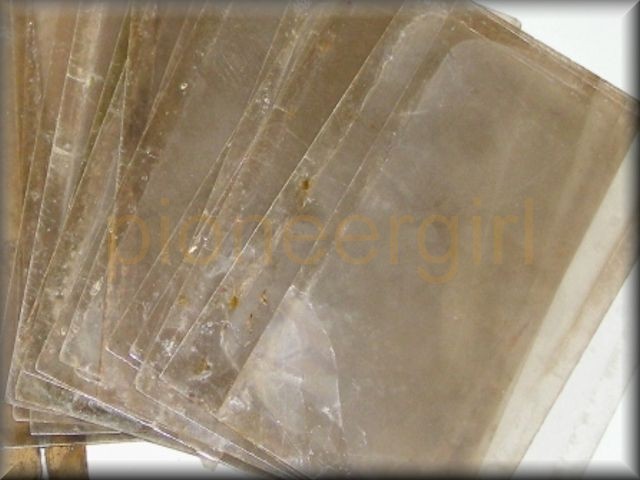isinglass

The sheets of mica, popularly so called. — Webster, 1882
 A little girl has developed a rain cape that attaches to an umbrella by snaps or fasteners. An isinglass window at about the level of the eyes would prevent the wearer from bumping into each other on the street. – Popular Science Monthly, July 1917.
A little girl has developed a rain cape that attaches to an umbrella by snaps or fasteners. An isinglass window at about the level of the eyes would prevent the wearer from bumping into each other on the street. – Popular Science Monthly, July 1917.
 Isinglass is what a geologist calls mica – more specifically muscovite – a mineral found in igneous or metamorphic rocks. The best way to identify mica is by its thin sheets that can be cleaved off. It’s transparent, flexible, and has the general appearance of clear to cloudy plastic, but it’s much harder and won’t melt, hence its use in high-temperature applications such as stoves and lamps.
Isinglass is what a geologist calls mica – more specifically muscovite – a mineral found in igneous or metamorphic rocks. The best way to identify mica is by its thin sheets that can be cleaved off. It’s transparent, flexible, and has the general appearance of clear to cloudy plastic, but it’s much harder and won’t melt, hence its use in high-temperature applications such as stoves and lamps.
Mica is still available and in use as insulators in electrical equipment, stove windows and lighting fixtures. It cuts fairly easily with a utility knife.
Henry Quiner and family lived near the Etta Mine, located in 1883 as a mica mine just south of present-day Keystone, South Dakota. I picked up pieces of mica along a trail while touring old Keystone-area mine locations with Bob Hayes in 2006. The navigation button shows sheets of mica sold to be cut into replacement stove windows.
In Little Town on the Prairie, Laura Ingalls Wilder seems to suggest that only wealthier residents in early day De Smet had heating stoves with isinglass windows in them, describing them with other pretty features in the Charles Tinkham and Horace Woodworth sitting rooms. Charles and Caroline Ingalls, however, had such a stove in their Third Street house, built in 1887; it is shown in a box camera photograph taken by Carrie Ingalls. A similar heater is on display in the museum-owned house today, so make sure to notice it when taking your next Laura Ingalls Wilder Memorial Society tour. Sadly, this heater has had its original isinglass windows replaced with plastic!
Isinglass, or Mica. This stone is so common, so bright, beautiful and curious, that we become acquainted with it when we are children and never forget it. I do not mean that every body always knows what is isinglass and what is not. Two or three other minerals look very much like it, which are different in some of their external character and also their internal.
Crystallized gypsum, or selenite, looks like it, but will not split so thin, and is not elastic–that is, if you bend it, it will not spring back. So are some kinds of talc.
Isinglass is flat, shining, and splits easily into sheets thinner than paper. It is soft, so as to be scratched with a pin, and is commonly transparent, so that, when laid on a printed or written page, you can read through it. It is commonly white or black, but sometimes smoke-colored, yellow, brown, silver or gold-colored, delicate green, rose, &c. When heated much, it becomes opaque; that is, you cannot see through it.
In some countries, where it is found in large sheets, it is used instead of window glass, as in Syria, &c. As it is not cracked by heat, it is often put into stoves and lanterns; and as it will bear jarring without breaking, the cabin windows of ships of war are sometimes made of it, because the firing of cannon often breaks glass.
Fish glue prepared very carefully looks like this stone, and is called isinglass. It is what is used in making blanc-mange, and sometimes in settling coffee. Some people think they are the same thing. — Theodore Dwight, The American Penny Magazine, Volume I (New York: 112 Broadway, 1845), 172.

isinglass (LTP 17, 20)

